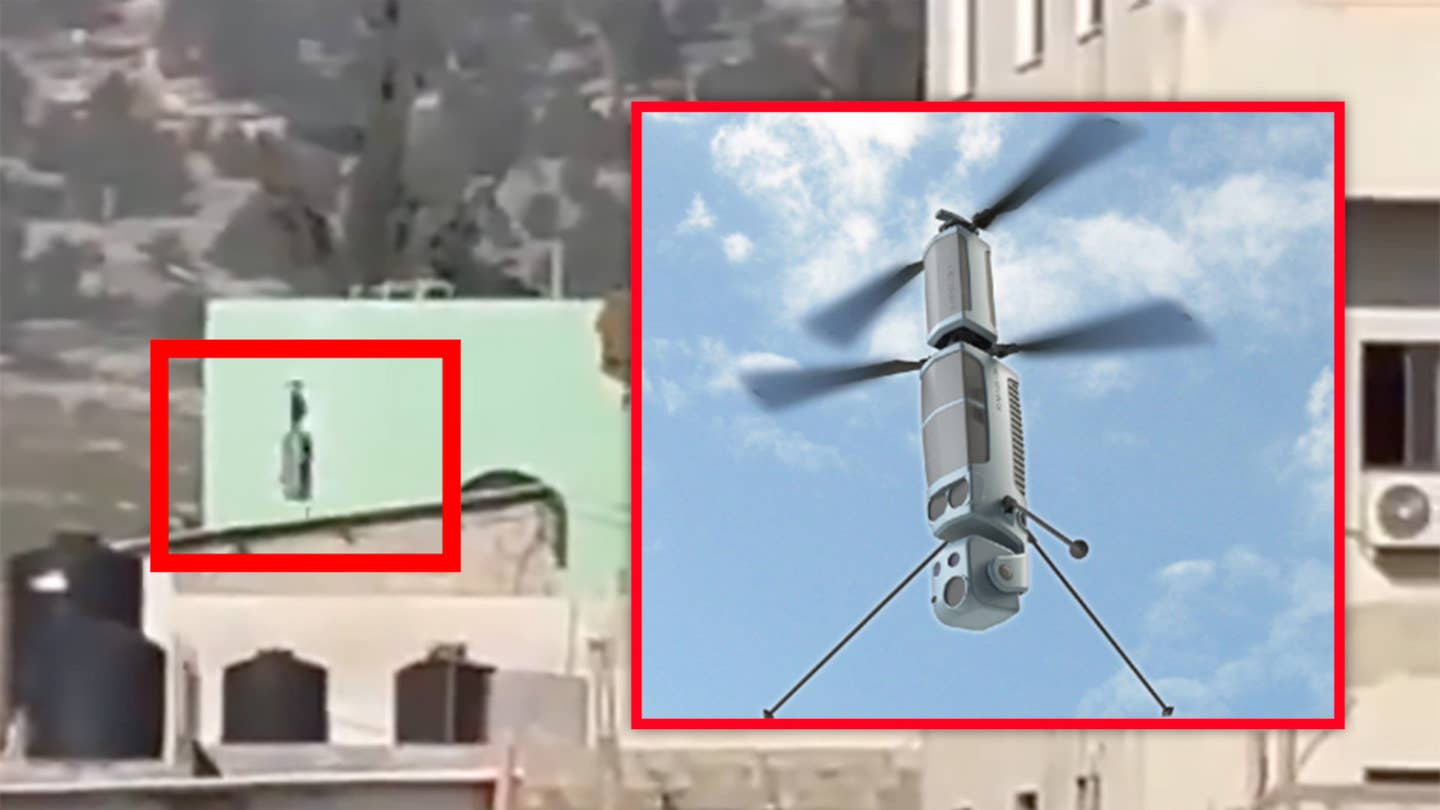The FireFly loitering munition has been seen for the first time in the current conflict as it flew over a West Bank neighborhood.

The first look at Israel’s Spike FireFly coaxial rotor loitering munition drone being used during the current conflict appears to have emerged. A new video combines two views of the weapons in use, most likely shot in the West Bank city of Jenin.
The first scene shows the drone, known in Hebrew as Moaz and made by Israel’s Rafael, slowly descending into a courtyard in a dense urban neighborhood. A second scene at the 11-second mark shows the FireFly hovering. We don’t know if these are two scenes from the same event, or two separate ones. The second part of the video was posted Monday by the Palestinian TubasTimes Telegram channel, which frequently reports on Israeli operations in that city. The video also shows the hilly terrain in that part of the West Bank.
The FireFly was designed to be used by maneuvering ground forces in dense urban areas where “situational awareness is limited, the enemy is fighting from behind cover and the effectiveness of fire support elements is reduced by the close proximity of noncombatants.”
That describes recent Israeli actions in Jenin, a West Bank hotspot where the Israeli Defense Forces (IDF) recently wrapped up a 60-hour operation in which it claimed to have arrested scores of Palestinians and recovered dozens of weapons.
FireFly is part of Rafael’s SPIKE family of precision-guided munitions, sharing guidance and other components from the SPIKE NLOS (non line-of-sight) missile. The vertical take off and landing (VTOL) drone is designed to offer beyond-line-of-sight (BLOS) lethality by operating both via within line-of sight operator-in-the-loop control, as well as autonomously via flying on autopilot to waypoints. It has a dual infrared and electro-optical (EO) seeker as well as proximity sensors. The weapon is capable of running down “agile targets” and it can fly inside windows and doors to strike enemies behind cover.
Weighing in a three kilograms (about 6.6 pounds), FireFly has two motors driving coaxial rotors designed for minimum noise and a compartment for either a 350-gram (0.77 pound) omnidirectional blast fragmentation warhead when in strike mode or an extra battery to extend its endurance from 15 to 30 minutes when in reconnaissance mode.
(Rafael)
It has a range of up to 1,000 meters (about 3,200 feet), with flight speeds up to 60 kph (37 mph) when maneuvering and 70 kph (43 mph) when diving in attack mode. The drone can be launched via a vehicle-mounted arrangement or carried by dismounted troops.
FireFly gives even small units the ability to scout ahead and engage threats from a relatively safe distance. The operator-in-the-loop function is simple to use and allows for a strike to be aborted in case noncombatants come into view, an intended target vacates the area or adapt to any other change in a dynamic battle zone. Above all else, it gives small units the flexible ability of being able to view ahead for scouting and investigating targets of opportunity. The drone’s coaxial rotor design gives it a small footprint and allows it to fly in very tight areas, including inside buildings.
Several other nations have expressed interest in FireFly. It was evaluated by the U.S. Army in 2022 at the Army Expeditionary Warrior Experiment 2022 at what was then Fort Benning, now Fort Moore. Troops from the Netherlands and U.K. also took part in the assessment, according to Rafael.
Over the course of two days, seven infantry squads were qualified in the operation of the loitering munition by using inert rounds and an embedded trainer that simulated the Firefly control unit, Shephard Media reported at the time. The squads also participated in force-on-force exercises within an urban area deploying Firefly munitions in different tactical scenarios to support infantry squad maneuvers.
This video below, released by Rafael, shows U.S. Army soldiers operating the FireFly, first to observe a target then to fly into an open window to destroy it.
It is unknown if the IDF is using FireFly in Gaza, though it certainly seems like it would be, given the tough urban fight there. We’ve reached out to the U.S. Army to find out its level of interest in this weapon after the 2022 demonstration. We will update this story with any details provided.
Israel has been pushing the boundaries in terms of drones optimized for urban combat operations that have a kinetic payload option. Elbit Systems’ LANIUS is another such system that has seen operational use. You can read all about it here and see it in action here.
These types of drones optimized for the urban fight are bound to become increasingly common and the fact that they can acts as scouts and as lethal weapons in their own right makes them incredibly flexible, while also being extremely tough to contend with for those in their crosshairs.
Contact the author: howard@thewarzone.com




